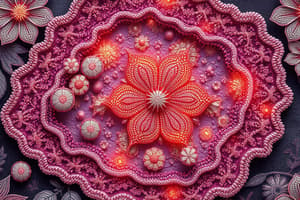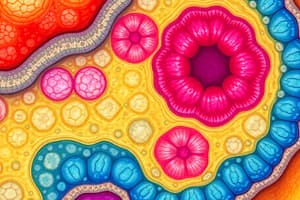Podcast
Questions and Answers
Name the four primary tissue types found in the human body and briefly describe the primary function of each.
Name the four primary tissue types found in the human body and briefly describe the primary function of each.
Epithelial (covering/lining), Connective (support), Muscular (movement), and Nervous (communication).
Differentiate between the terms 'simple' and 'stratified' when describing epithelial tissues.
Differentiate between the terms 'simple' and 'stratified' when describing epithelial tissues.
Simple refers to a single layer of cells, while stratified refers to multiple layers of cells.
Describe the key characteristics of epithelial tissue that enable it to perform its function of protection.
Describe the key characteristics of epithelial tissue that enable it to perform its function of protection.
Tightly packed cells forming protective layers, continuously regenerative, and avascular nature relying on underlying tissues for nutrients.
Explain how the structure of simple squamous epithelium relates to its function, providing an example of where this tissue type is found.
Explain how the structure of simple squamous epithelium relates to its function, providing an example of where this tissue type is found.
How does the arrangement of fibers in dense regular connective tissue contribute to its function?
How does the arrangement of fibers in dense regular connective tissue contribute to its function?
Describe the major difference between dense regular and dense irregular connective tissues and where each would typically be found in the body.
Describe the major difference between dense regular and dense irregular connective tissues and where each would typically be found in the body.
Explain the functional significance of having no blood vessels within epithelial tissue.
Explain the functional significance of having no blood vessels within epithelial tissue.
What are the main components of connective tissue and how do they contribute to its overall function?
What are the main components of connective tissue and how do they contribute to its overall function?
Describe the distinguishing characteristic of adipose tissue and explain its primary function.
Describe the distinguishing characteristic of adipose tissue and explain its primary function.
What is the key structural difference between hyaline cartilage, elastic cartilage, and fibrocartilage and how does this relate to their function?
What is the key structural difference between hyaline cartilage, elastic cartilage, and fibrocartilage and how does this relate to their function?
What is the major structural component that makes bone a hard tissue and how are the cells arranged within it?
What is the major structural component that makes bone a hard tissue and how are the cells arranged within it?
How does blood differ from other types of connective tissue in terms of its matrix?
How does blood differ from other types of connective tissue in terms of its matrix?
Describe the general characteristics of epithelium.
Describe the general characteristics of epithelium.
What gives connective tissue such diverse functions?
What gives connective tissue such diverse functions?
How does pseudo stratified epithelium appear and where is it found?
How does pseudo stratified epithelium appear and where is it found?
Considering its tissue classification, why isn't blood considered a 'lining'?
Considering its tissue classification, why isn't blood considered a 'lining'?
Why do epithelial cells form protective layers?
Why do epithelial cells form protective layers?
What causes elastic cartilage to be elastic?
What causes elastic cartilage to be elastic?
What part of the bone makes it so hard?
What part of the bone makes it so hard?
Why is loose connective tissue also called areolar connective tissue?
Why is loose connective tissue also called areolar connective tissue?
Flashcards
What is a cell?
What is a cell?
The smallest unit of life.
What is a tissue?
What is a tissue?
A group of cells with similar structure/function.
What is an organ?
What is an organ?
Two or more tissues working together.
What is an organ system?
What is an organ system?
Two or more organs working together.
Signup and view all the flashcards
What is Epithelial Tissue?
What is Epithelial Tissue?
Covers/lines surfaces; e.g., skin, blood vessels.
Signup and view all the flashcards
What is Muscular Tissue?
What is Muscular Tissue?
Provides movement via contraction; e.g., muscles.
Signup and view all the flashcards
What is Nervous Tissue?
What is Nervous Tissue?
Neurons that transmit electrical signals.
Signup and view all the flashcards
What is Connective Tissue?
What is Connective Tissue?
Supports and holds things together; e.g., bone, blood.
Signup and view all the flashcards
Function of Epithelial Tissue?
Function of Epithelial Tissue?
Covers body's external and internal surfaces.
Signup and view all the flashcards
What is Simple Epithelium?
What is Simple Epithelium?
Single layer of cells.
Signup and view all the flashcards
What is Stratified Epithelium?
What is Stratified Epithelium?
Multiple layers of cells.
Signup and view all the flashcards
What is Squamous Epithelium?
What is Squamous Epithelium?
Flat and thin cells.
Signup and view all the flashcards
What is Cuboidal Epithelium?
What is Cuboidal Epithelium?
Round or square cells.
Signup and view all the flashcards
What is Columnar Epithelium?
What is Columnar Epithelium?
Tall cells.
Signup and view all the flashcards
Function of Connective Tissue?
Function of Connective Tissue?
Supports the body and connects parts.
Signup and view all the flashcards
What is Areolar Connective Tissue?
What is Areolar Connective Tissue?
Contains lots of fibers and matrix, few cells.
Signup and view all the flashcards
What is Adipose Tissue?
What is Adipose Tissue?
Cells contain large fat stores.
Signup and view all the flashcards
What is Dense Connective Tissue?
What is Dense Connective Tissue?
Tightly packed parallel fibers.
Signup and view all the flashcards
Types of cartilage?
Types of cartilage?
Elastic, hyaline and fibro.
Signup and view all the flashcards
Function of blood?
Function of blood?
Transport of nutrients and immunity.
Signup and view all the flashcardsStudy Notes
- Tissues and the respiratory system are covered in Chapter 2, pages 43-48, and Chapter 4 of the textbook.
Intro & Epithelial Tissue
- The four levels of structural organization are cell, tissue, organ, and system.
- There are four types of tissue which need to be defined.
- Epithelial tissue's structure, function, and location needs to be described.
- Epithelial tissue can be covering or glandular and must be characterized.
- Epithelial tissues are categorized as simple, stratified, squamous, cuboidal, columnar, pseudostratified, and/or transitional.
Levels of Organization
- The smallest unit of life is a cell.
- A tissue is an association of cells with the same general structure and function.
- An organ is an association of several tissue types that carry out a specific function.
- An organ system is two or more organs working together to perform a general function like digestion or movement.
4 Types of Tissue
- Epithelial tissue covers/lines exterior surfaces and internal cavities/tubes, such as skin, blood vessels, stomach lining, and intestines.
- Muscular tissue provides movement through contraction and relaxation.
- Nervous tissue is made of neurons (specialized cells) that send electrical signals along their membranes.
- Connective tissue supports and holds things together, including bone, cartilage, blood, fat, ligaments, tendons, and loose connective tissue.
Epithelial Tissue (Lining)
- Covers the body's external and internal surfaces.
- Makes up the outer surface of the skin.
- Lines most internal cavities like the stomach, throat, blood vessels, and digestive tract.
- Major functions include protection (e.g., skin and organ coverings), secretion (e.g., producing fluids/mucus in the respiratory tract), absorption of substances (e.g., stomach lining, alveoli in lungs, and blood vessels), and filtration (e.g., kidney).
General Characteristics of Epithelium
- Epithelium is a lining tissue with a free or unattached apical surface open to the outside or an internal cavity, and is fixed to a basal section attached to connective tissue.
- Lacks blood vessels, so cells absorb nutrients from the layer below.
- Cells are tightly held for protection.
- Has the ability to regenerate quickly, which is good for tissues like skin.
Categories of Epithelial Tissue
- Epithelial tissue is categorized by the number of cell layers and the shape of the cells.
- Simple epithelium has a single layer.
- Stratified epithelium has multiple layers.
- Squamous cells are flat and thin.
- Cuboidal cells are round or square.
- Columnar cells are tall.
Simple Epithelium
- Simple squamous epithelium allows for rapid absorption/diffusion and secretes lubricating substances; it is found in air sacs (alveoli) of lungs and lining of blood vessels.
- Simple cuboidal epithelium's location is the lining of kidney tubules, and its function is absorption and secretion of substances.
- Simple columnar epithelium's location is ciliated in lining bronchi and uterine tubes and smooth in the digestive tract, which allows for absorption of substances, secretes mucus and enzymes, and moves substances across the cell surface.
- Pseudostratified columnar epithelium lines the trachea and upper respiratory tract, secreting mucus and moving mucus across the surface.
Stratified Epithelium
- Stratified squamous epithelium functions to protect against abrasion; found in skin and lines the esophagus, mouth, and vagina.
- Stratified cuboidal epithelium provides protective tissue, and is found in sweat glands, salivary glands, and mammary glands.
- Stratified columnar epithelium secretes substances and provides protection, and is found in the male urethra and ducts of some glands.
- Transitional epithelium, found in the bladder, urethra, and ureters, allows urinary organs to expand and stretch.
Connective Tissue
- Connective tissue is abundant and widespread, basically anything that isn't muscle/nerve/lining tissue.
- Supports the body and helps to hold/connect body parts.
- Examples are bone for support, blood to transport nutrients, tendons and ligaments for attaching/connecting, fat for cushion/nutrient storage, cartilage for protection/support, and loose connective tissue to hold organs in place.
Characteristics of Connective Tissue
- Cells are not held closely together but spread out.
- Non-cellular material (matrix) separates the cells.
- The matrix can be solid (bone), liquid (blood), or a mesh of fibers and fluid (other connective tissue types).
- Fibers (protein chains) hold pieces together for expansion, contraction, and elasticity.
Areolar (Loose) Connective Tissue
- Lots of criss-crossing fibers.
- Lots of space/matrix/fluid.
- Has few cells (fibroblasts).
- It holds organs together.
- Strong enough to bind tissues, soft enough to provide flexibility and cushioning.
Adipose Tissue
- A special type of loose connective tissue, commonly known as fat tissue.
- Cells contain a large fat store, with the cytoplasm and organelles squashed in a corner.
- Stores fat for insulation and nutrient storage.
- Found in fat deposits around the body.
Dense (Regular) Connective Tissue
- Has tightly packed parallel fibers, sometimes in a wavy pattern.
- Located in tendons and ligaments that hold bones together and attach muscles to bones.
- Regularly arranged, long bundles of fibers make it very strong.
Cartilage
- Smooth, elastic tissue in joints.
- Contains fluid/matrix between cells to provide a smooth sliding surface.
- Elastic cartilage is found in the ears.
- Hyaline cartilage is found at the ends of bones (smooth sliding surface).
- Fibrocartilage is located between vertebrae.
- Cartilage is identified by a "cell in a bubble" (chondrocyte in a lacuna).
Bone
- Bone cells are surrounded by mineral deposits (matrix) to make the tissue hard.
- Cells are arranged in rings (looks like tree rings).
- Provides major structure and support.
- Located in bones.
Blood
- Blood is a special type of connective tissue.
- Has small and some large cells floating in a liquid.
- Made of plasma/liquid matrix.
- Transports nutrients and provides immunity.
Studying That Suits You
Use AI to generate personalized quizzes and flashcards to suit your learning preferences.




